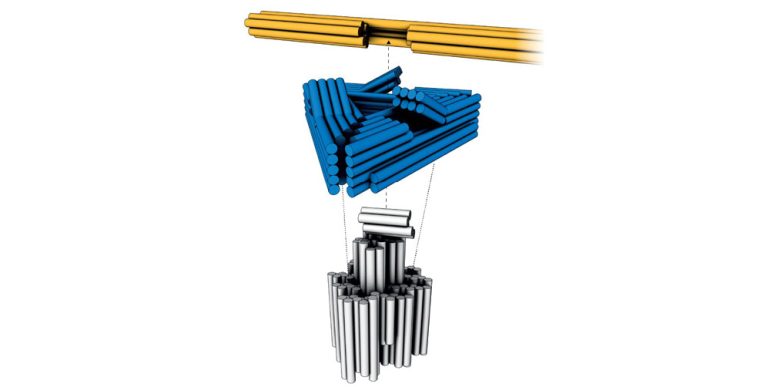Genetic material as motor: For the first time, scientists have converted the genetic molecule DNA into an electric motor at the nanoscale. To do this, they assembled several DNA strands in such a way that they formed a pedestal with a rotor arm. If voltage is applied now, the DNA rotor begins to move and twist in one direction, as the researchers report in the journal “Nature.” The new nano-electric motor opens up the possibility of driving nano-processes and chemical reactions in new ways.
Motors have been liberating mankind from work for many centuries. Their main function is to convert various forms of energy into motion – even on the smallest scales. there is now nanomotorsOnly he one nanometer in size are and from genetic molecule made of DNA became. However, so far, the latter have only been able to generate motion from chemical energy – not electrical energy.
origami with genetic material molecules
A team led by first author Anna-Kathrina Pum from the Technical University of Munich has now fabricated a nano-sized electric motor made of DNA. To assemble the molecular motor, scientists used a technique known as DNA origami. With this construction method, several long single strands of genetic material serve as the parent structure, to which further complementary DNA segments are added. Sequences of molecules are selected in such a way that desired structures arise from attachments and folds.
“We’ve been working with this method for many years and can now develop very precise and complex objects like molecular switches and hollow bodies that can hold viruses. If you put a DNA strand with the corresponding sequences in solution , then the objects assemble themselves,” explains senior author Hendrik Dietz from the Technical University of Munich.
Base, Platform, Rotor
The researchers used the origami technique to build the three components for their new DNA motor. They are based on a base about 40 nanometers high, which is attached to a glass plate with the help of polyethylene glycol. A DNA platform 13 nanometers thick is then mounted on the leg, which connects the base to a 500 nanometer long rotor arm made of DNA. The composition of the intermediate element is responsible for the function of the engine.
Basically, the DNA motor acts like a kind of ratchet. The intermediate platform has constraints that limit the rotation of the rotationally mounted arm. Without a specific supply of energy, the rotor moves randomly and uncontrollably, as it is affected only by collisions with solvent molecules. However, as soon as an AC voltage is applied through the two electrodes, the arm rotates in a targeted and continuous manner in the desired direction. Finally, scientists can influence the speed and direction of rotation through the direction of the field and the frequency and amplitude of the voltage.
“Technically Unmatched Skills”
“The new motor has unmatched mechanical capabilities,” says co-author Ramin Golestanian from the Max Planck Institute for Dynamics and Self-Organization in Göttingen. “It can achieve torque in the range of 10 piconewton by nanometer. And it can generate more energy per second than the energy released by splitting two ATP molecules.
Scientists hope that the motor they have developed will be used in the future for specific technical tasks, such as converting electrical energy into chemical energy. “We could potentially use it to drive chemical reactions along the lines of ATP production. For example, surfaces could be densely coated with such motors,” Dietz explains. “Then you combine the raw materials, apply a little AC power, and the motors produce the desired chemical compound.” (Nature, 2022; doi:10.1038/s41586-022-04910-Y,
Source: Technical University of Munich

Internet fan. Alcohol expert. Beer ninja. Organizer. Certified tv specialist. Explorer. Social media nerd.





